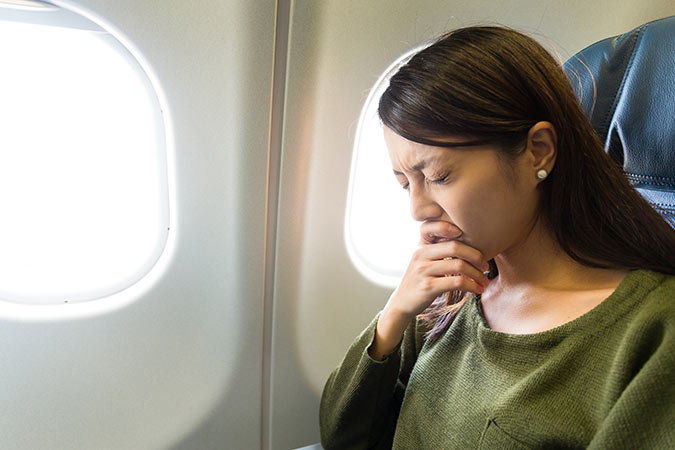Novelist Erica Jong is the only person who made fear of flying funny–and profitable. Jonathan, a 25-year-old patient of mine, has had an un-funny case of fear of flying since 9/11. His work often demands that he get on a plane, and each time it’s a heart-bursting, white-knuckled nightmare.
Of course, Jonathan is not alone. Many people have fear of flying, and people who have anxiety issues have it really bad, especially when the news report multiple airline disasters within a matter of months. Like now.
Two airline disasters in a matter of a few months is enough to exacerbate an existing fear of flying to the point where flying seems simply not possible.
To help Jonathan, I introduced him to my Reluctant Flyer Protocol — a simple, three-part training designed to tame anxiety. The three-step, mind-training program integrates Mindfulness, Self-soothing, Hypnosis and Cognitive therapy. To help the myriad others who, like Jonathan, may have had a spike in anxiety because of the recent airline tragedies, I’m putting out the Reluctant Flyer Protocol.
Having know-how in anxiety-taming self help goes a long way in gaining advantage of exaggerated fear. So, everyone overcome with air travel anxiety, take three minutes to master the three steps to taking charge and subduing your fear.

PART ONE: MINDFULNESS: Getting Comfortable with Being Uncomfortable
Getting comfortable with being uncomfortable is the lesson we learn in the very first seconds of our lives. I digress to make a point. Some of us forget this lesson and yet, it is the first lesson for a very good reason. It’s the survival lesson. People who forget it must practice mindfulness to relearn it, sometimes over and over. Mindfulness is a technique that helps us deal with discomfort instead of losing our heads over it.
In a nutshell, mindfulness is simply observing the experience of discomfort in your body, your mind, and your emotions in the moment. Now. remember, mindfulness is observing, as if detached, the fear-induced reactions in your body, mind and feelings. The detachment, while observing, provides a non-judgmental vantage point, a new perspective of the charged situation. The detachment, or distance, relieves the pressure of the perceived danger and provides opportunity to acknowledge and accept fear. Acknowledging fear and accepting it, paradoxically, reduces its power.
By saying “Hello!” to that which frightens you, makes you more comfortable with exactly what frightens you. Most of us don’t actually remember crying “Hello, World!” with our first breath. But, all of us have to say “Hello, Life” every exciting and terrifying moment of our lives. And we seldom realize we’re practicing mindfulness.
For those who suffer from anxiety, it’s important to be aware of the means and ways of survival: getting comfortable with being uncomfortable.
PART TWO: SELF-HYPNOSIS
Hypnosis is a shortcut to relaxation, and relaxation reduces anxiety. Hypnosis, actually, is a very natural state of mind. Our minds naturally go in and out of the state of hypnosis many times a day. Because in the state of hypnosis our attention focus narrows, our concentration on that narrow focus of attention intensifies and we become more receptive and open to the suggestions of our minds.
Because of this increased receptivity, our minds take off for the state of hypnosis on their own. Sometimes, however, it’s necessary to get our minds there on purpose and immediately.
Four easy and effective ways to move into a calmer state with hypnosis:
- Get into a comfortable position
- Focus on your breathing
- Relax, one by one, every muscle in your body
- Imagine going to a safe place where you feel calm and relaxed
PART THREE: COGNITIVE BEHAVIORAL THERAPY
If you’re an adult, or even a teenager with babysitting experience, you know how to talk to an upset toddler. Or a beloved pet. “Did you get yourself a boo-boo? Yes, you did! Well, we’re going to put on it a lovely little ice-cube, and it will stop hurting. See, isn’t it all better?”
Talking back to the worried brain with cognitive therapy is based on the premise that identifying your thoughts will change your feelings and behavior.
So, people anxious about flying, can start by identifying the thoughts feeding their fear. The process is quite simple. One begins by interviewing one’s own brain. What exactly am I most afraid of? The more specific the response, the more specific can be the inner dialogue. For example, if the most scary thing is an airplane crash, the response can be a reminder that in fact, travel by car is way more dangerous than air travel. Statistics can be quite calming. But statistics are not the point. The point is engagement with the thoughts that cause feelings of anxiety. It’s the old good cop, bad cop strategy, except, the frightened flyer plays both roles in order to regain and retain composure.
Here’s a three-step process to regain control of your emotions:
- Catch the worry in full, declarative sentence form. Write it down.
- Evaluate the accuracy and validity of the thought.
- Replace the worry (thought) with a more objective, more reassuring thought.
A few generalities about coping with anxiety:
- It’s important to acknowledge and respect your fear and your worrying self.
- You can acknowledge your fear and let it be, but you cannot allow your anxious self to take control.
- By trusting yourself to be able to step out of your comfort zone, you can face your fear, and by using the simple techniques we outlined here, you can reduce your fear and anxiety levels and regain and retain control of your emotions.
You can read more about overcoming the common phobia of flying in my book Anxiety Disorders: The Go-to guide. (Available on Amazon.)
Dr. Carolyn Daitch and her colleagues treat a wide range of fears and anxiety disorders at The Center for the Treatment of Anxiety Disorders in Farmington Hills, Michigan.
